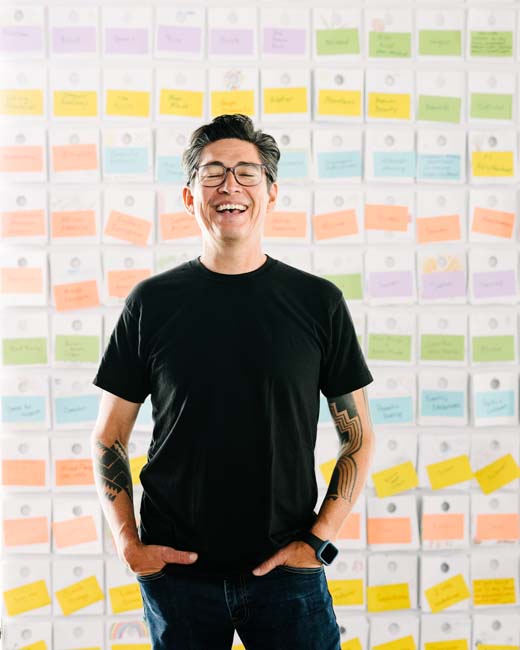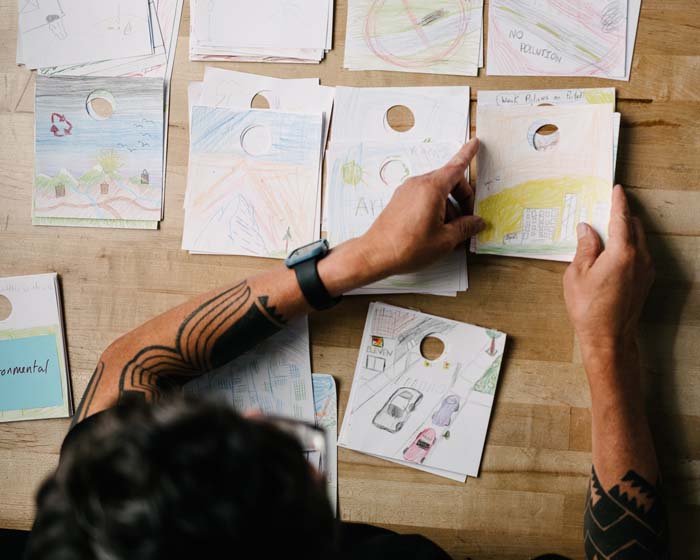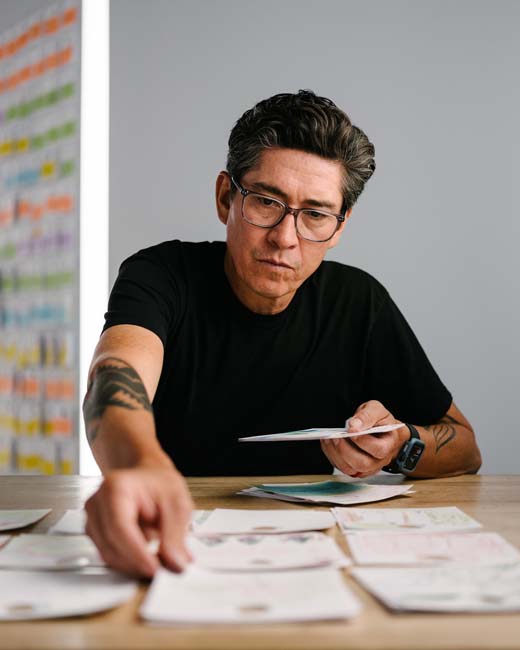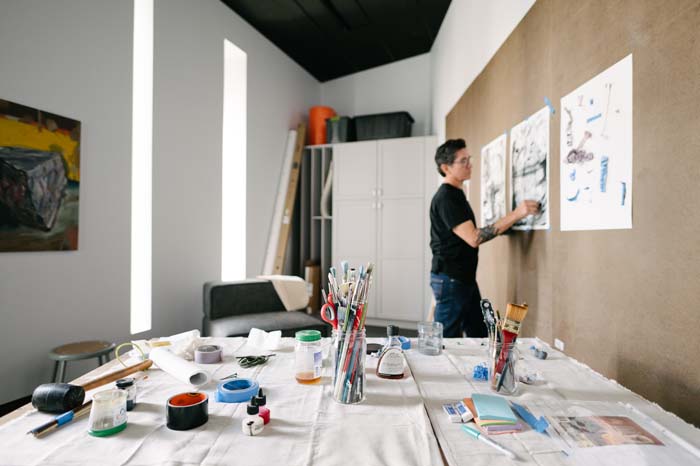Colorado-based artist Steven Yazzie (Diné, Laguna Pueblo, European ancestry) thinks of his art studio as community and land rather than an insular space bound by four walls.
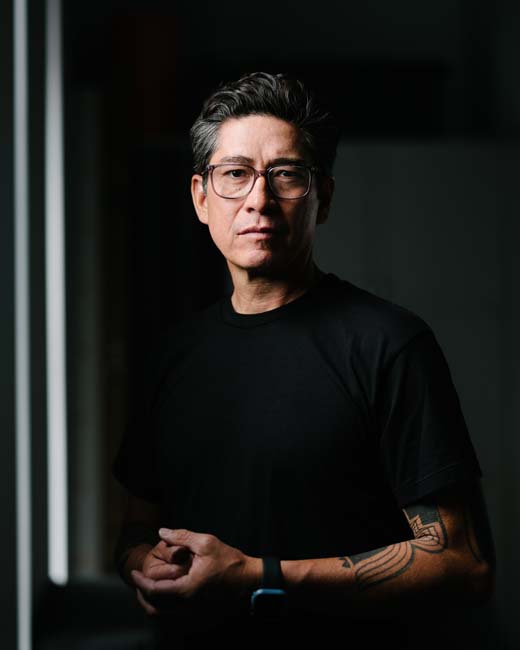
A rotating selection of paintings lines the walls inside the home studio of Steven Yazzie (Diné, Laguna Pueblo, European ancestry), a multi-disciplinary artist based in Denver, Colorado who works primarily in painting, installation, film/video, and community. Some picture landforms, and others the coyotes he paints in human settings as a way to confront human encroachments on the natural world.
Early on, Yazzie’s art practice centered on painting. But nowadays he’s busy with projects that take him outside the studio environment.
“The space is more or less an archive of some of my older work,” Yazzie says of the basement studio he typically uses for editing video projects.
From Yazzie’s perspective, his studio is a nomadic space connected to community and land. “There’s an evolution in the way artists with a multidisciplinary approach think about studios, because so much of what we do hap- pens beyond the confines of four walls,” reflects Yazzie. “I think of studios as insular tools and spaces.”
He has lived in Denver for about five years, but also has strong connections to Santa Fe, New Mexico and Phoenix, Arizona.
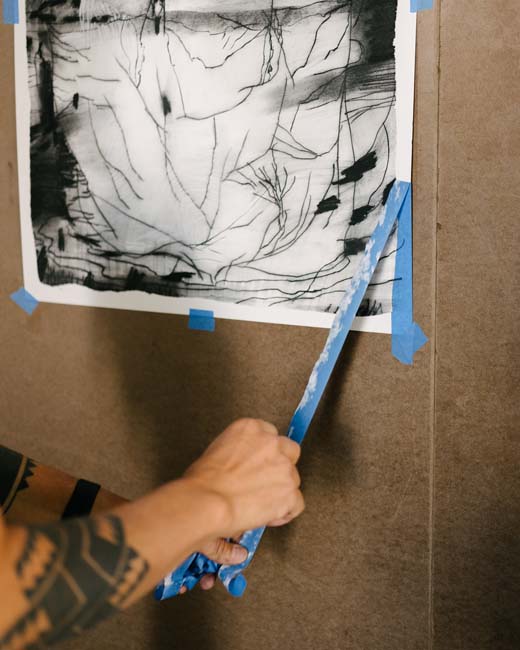
Recently, Yazzie had studio space inside the Denver Art Museum, where his term as the Native Arts Artist-in-Residence began in January and concluded in August. While there, he worked with community members and collaborators to create a short film called Knowing You, Denver designed to “explore Denver’s diverse cultural landscape.” In 2015, Yazzie did a similar project through the IAIA Museum of Contemporary Native Arts in Santa Fe.
“More and more, my work is about sharing experiences with others,” he says. “Maybe it comes with age, or just being bored of hearing my own voice.”
More and more, my work is about sharing experiences with others. Maybe it comes with age, or just being bored of hearing my own voice.
In May, Yazzie debuted Gold King & Associates, which explores issues related to land use through a real estate–style sign installed in a front yard in Colorado Springs. The location is actually an art space called the Yard, which was created by artists Ben Kinsley and Jessica Langley to highlight domestic spaces as sites of innovation. People call the phone number on the sign, assuming the house they’ve seen is for sale. Instead of reaching a real estate office, they hear a recording and get the chance to leave their own message.
The project is titled after the Gold King Mine—where a 2015 wastewater spill impacted waterways in Colorado, New Mexico, Utah, and the Navajo Nation—and is designed to critique capitalist concepts such as private property while drawing attention to issues of colonization, urbanization, and over-development. Every week, the recording has featured a different person performing a poem, quote, or excerpt from a story. In many ways, it’s similar to J.W. Powell & Associates, a 2013 project realized in Arizona and New Mexico in which the artist used similar signs and recordings to address “environmental concerns around water and urban development in the American West.” In both cases, Yazzie incorporated signs using the word “reality” rather than “realty.”
Clearly, land-related themes are prevalent in Yazzie’s creative practice, which spans more than two decades. In 1999, Yazzie painted Fear of a Red Planet, a mural addressing forced relocation and removal of Indigenous people in the Southwest, for the Heard Museum in Phoenix. In Beyond the Landscape, a series of abstracted landscape paintings from 2010 to 2015, Yazzie explored the personal and cultural contexts of places the artist calls “the landforms of my life.” In 2004, Yazzie launched Driving and Drawing, an ongoing project fusing movement and landscape, where the artist draws what he sees while operating a custom-built vehicle, thus co-creating artworks with the terrain beneath him as it impacts how his lines are manifested on the page. “This,” he recalls, “is where I began creating work in the land.”

In 2007, Yazzie co-founded the Indigenous arts collective Postcommodity with Kade L. Twist (Cherokee) and Nathan Young (Delaware Tribe of Indians, Pawnee, Kiowa). More recently, he co-founded the Museum of Walking with artist Angela Ellsworth. “It fit into the work I was doing about the body moving through space and experiencing the land as a community,” he explains of the project launched in 2014. That same year, Yazzie and his wife Eileen Yazzie co-founded Digital Preserve, a video and film production company that centers “the relevance and importance” of Indigenous people.
Currently, Yazzie’s Yuméweuš (2022) is featured in the New Earthworks exhibition at Arizona State University Art Museum in Tempe, Arizona. The installation includes a futuristic, totemic hydroponics tower planted with the ancient grain amaranth, along with a sand painting depicting its chemical structure and a projection with wording culled from various university and city land acknowledgements.
Yazzie has plenty of other projects in the works, including a collaboration with Canada-based artist Catherine Blackburn (Dene, European ancestry) that incorporates performance and film. He’s been working on a new video installation for the exhibition Substance of Stars opening at the Heard Museum in November, and says he’s looking forward to his first co-curatorial experience—a mural exhibition at RedLine Contemporary Art Center in Denver.
Given the ways Yazzie moves between geographies, collaborations, materials, and ideas, it’s no wonder he doesn’t feel bound by traditional views of studio space.
“I’m less a studio artist than a migrating artist,” he says.
